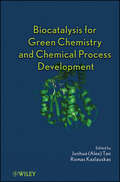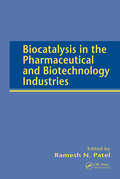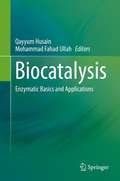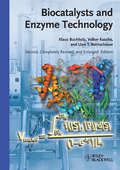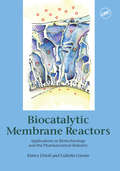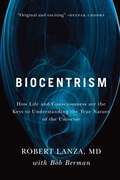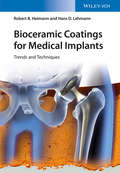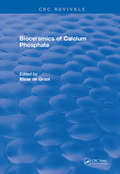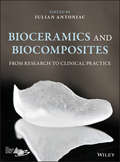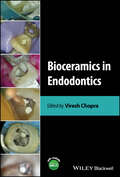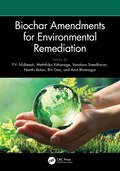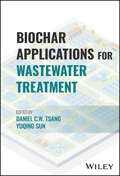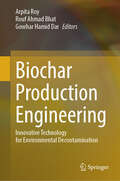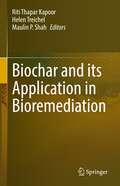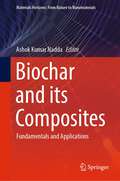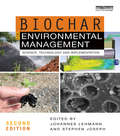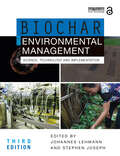- Table View
- List View
Biocatalysis for green chemistry and chemical process development
by Junhua Alex Tao Romas KazlauskasThis book describes recent progress in enzyme-driven green syntheses of industrially important molecules. The first three introductory chapters overview recent technological advances in enzymes and cell-based transformations, and green chemistry metrics for synthetic efficiency. The remaining chapters are directed to case studies in biotechnological production of pharmaceuticals (small molecules, natural products and biologics), flavors, fragrance and cosmetics, fine chemicals, value-added chemicals from glucose and biomass, and polymeric materials. The book is aimed to facilitate the industrial applications of this powerful and emerging green technology, and catalyze the advancement of the technology itself.
Biocatalysis in Polymer Chemistry
by Katja LoosSearching for green and environmentally friendly polymerization methods by using enzymes? This first handbook on this hot and essential topic contains the whole chain of knowledge of biocatalysis in polymer chemistry in both a comprehensive and compact form. International leading experts cover all important aspects, from enzymatic monomer synthesis to polymer modification and degradation. While the major focus of the book is on enzymatic polymerizations of the polymer classes reported so far, industrial contributions are also included, making this invaluable reading for biochemists and polymer chemists working in academia and industry.
Biocatalysis in the Pharmaceutical and Biotechnology Industries
by Ramesh N. PatelBecause enzyme-catalyzed reactions exhibit higher enantioselectivity, regioselectivity, substrate specificity, and stability, they require mild conditions to react while prompting higher reaction efficiency and product yields. Biocatalysis in the Pharmaceutical and Biotechnology Industries examines the use of catalysts to produce fine chemic
Biocatalysis: Enzymatic Basics and Applications
by Mohammad Fahad Ullah Qayyum HusainThis book introduces readers to industrially important enzymes and discusses in detail their structures and functions, as well as their manifold applications. Due to their selective biocatalytic capabilities, enzymes are used in a broad range of industries and processes. The book highlights selected enzymes and their applications in agriculture, food processing and discoloration, as well as their role in biomedicine. In turn, it discusses biochemical engineering strategies such as enzyme immobilization, metabolic engineering, and cross-linkage of enzyme aggregates, and critically weighs their pros and cons. Offering a wealth of information, and stimulating further research by presenting new concepts on enzymatic catalytic functions in basic and applied contexts, the book represents a valuable asset for researchers from academia and industry who are engaged in biochemical engineering, microbiology and biotechnology.
Biocatalysts and Enzyme Technology
by Klaus Buchholz Uwe Theo Bornscheuer Volker KascheThis second edition of a bestselling textbook offers an instructive and comprehensive overview of our current knowledge of biocatalysis and enzyme technology. The book now contains about 40% more printed content. Three chapters are completely new, while the others have been thoroughly updated, and a section with problems and solutions as well as new case studies have been added. Following an introduction to the history of enzyme applications, the text goes on to cover in depth enzyme mechanisms and kinetics, production, recovery, characterization and design by protein engineering. The authors treat a broad range of applications of soluble and immobilized biocatalysts, including wholecell systems, the use of non-aqueous reaction systems, applications in organic synthesis, bioreactor design and reaction engineering. Methods to estimate the sustainability, important internet resources and their evaluation, and legislation concerning the use of biocatalysts are also covered.
Biocatalytic Membrane Reactors: Applications In Biotechnology And The Pharmaceutical Industry
by Lidietta Giorno Enrico DrioliThis research level reference book has been co-written by Enrico Drioli, perhaps one of the world's best known researchers into membrane technology. The application of membrane technology to chemical transformation and molecular separation are beginning to be exploited in the pharmaceutical science and biotechnology industries, but there is a need for researchers and students to have up-to-date literature - and this book provides it. The book will be of interest to students of chemistry, chemical engineering, pharmacy and biotechnology.
Biocentrism: How Life and Consciousness are the Keys to Understanding the True Nature of the Universe
by Bob Berman Robert LanzaRobert Lanza is one of the most respected scientists in the world — a US News & World Report cover story called him a &“genius" and a &“renegade thinker," even likening him to Einstein. Lanza has teamed with Bob Berman, the most widely read astronomer in the world, to produce Biocentrism, a revolutionary new view of the universe. Every now and then a simple yet radical idea shakes the very foundations of knowledge. The startling discovery that the world was not flat challenged and ultimately changed the way people perceived themselves and their relationship with the world. For most humans of the 15th century, the notion of Earth as ball of rock was nonsense. The whole of Western, natural philosophy is undergoing a sea change again, increasingly being forced upon us by the experimental findings of quantum theory, and at the same time, towards doubt and uncertainty in the physical explanations of the universe's genesis and structure. Biocentrism completes this shift in worldview, turning the planet upside down again with the revolutionary view that life creates the universe instead of the other way around. In this paradigm, life is not an accidental byproduct of the laws of physics. Biocetnrism takes the reader on a seemingly improbable but ultimately inescapable journey through a foreign universe—our own—from the viewpoints of an acclaimed biologist and a leading astronomer. Switching perspective from physics to biology unlocks the cages in which Western science has unwittingly managed to confine itself. Biocentrism will shatter the reader's ideas of life--time and space, and even death. At the same time it will release us from the dull worldview of life being merely the activity of an admixture of carbon and a few other elements; it suggests the exhilarating possibility that life is fundamentally immortal. The 21st century is predicted to be the Century of Biology, a shift from the previous century dominated by physics. It seems fitting, then, to begin the century by turning the universe outside-in and unifying the foundations of science with a simple idea discovered by one of the leading life-scientists of our age. Biocentrism awakens in readers a new sense of possibility, and is full of so many shocking new perspectives that the reader will never see reality the same way again.
Bioceramic Coatings for Medical Implants
by Robert B. Heimann Hans D. LehmannReflecting the progress in recent years, this book provides in-depth information on the preparation, chemistry, and engineering of bioceramic coatings for medical implants. It is authored by two renowned experts with over 30 years of experience in industry and academia, who know the potentials and pitfalls of the techniques concerned.Following an introduction to the principles of biocompatibility, they present the structures and properties of various bioceramics from alumina to zirconia. The main part of the work focuses on coating technologies, such as chemical vapor deposition, sol-gel deposition and thermal spraying. There then follows a discussion of the major interactions of bioceramics with bone or tissue cells, complemented by an overview of the in-vitro testing methods of the biomineralization properties of bioceramics. The text is rounded off by chapters on the functionalization of bioceramic coatings and a look at future trends.As a result, the authors bring together all aspects of the latest techniques for designing, depositing, testing, and implementing improved and novel bioceramic coating compositions, providing a full yet concise overview for beginners and professionals.
Bioceramic Materials in Clinical Endodontics
by Josette Camilleri Saulius DrukteinisThis book focuses on hydraulic calcium silicate-based materials available in clinical dentistry, used as pulp capping materials, root canal sealers, root-end fillers, or root repair materials and which offer improved properties and easier clinical application compared with the original mineral trioxide aggregate. The book introduces the current classification of bioceramic materials and explains their characterization and their physicochemical and biological properties. Thereafter, the various clinical applications of these materials are discussed in depth with reference to the evidence base. The coverage includes applications in endodontic treatments and complications, traumatic dental injuries, management of the vital pulp in both dentitions, and regenerative endodontic procedures. Apart from presenting the latest research on hydraulic calcium silicate-based materials, Bioceramic Materials in Clinical Endodontics promotes an essential balance between basic laboratory and clinical research. It will thus be an important reference for materials science specialists, clinical researchers, and clinicians.
Bioceramics
by James F. ShackelfordThe main sections/chapters of the book focus on the composition of nine types of bioceramics, other simple oxides and more and the medical applications of these materials in orthopaedics, dentistry and the treatment of cancerous tumors.
Bioceramics Calcium Phosphate
by K. de GrootThe first chapters are fundamental, in that the physical chemistry of calcium phosphate salts is discussed, along with mineralization (with emphasis on teeth) and remodelling of mineralized tissues. Thereafter follows a treatment of the influence of implants o surrounding hard tissues. This topic is followed by a chapter on preparation methods and biomechanical and biological aspects of calcium phosphate implants. In conclusion, two chapters are devoted to (possible) dental and medical applications. It is hoped that basic researchers can use the book in their efforts to improve this promising class of materials further, and that clinicians are inspired to define further possibilities and � at least as important � limitations.
Bioceramics and Biocomposites: From Research to Clinical Practice
by Iulian AntoniacProvides comprehensive coverage of the research into and clinical uses of bioceramics and biocomposites Developments related to bioceramics and biocomposites appear to be one the most dynamic areas in the field of biomaterials, with multiple applications in tissue engineering and medical devices. This book covers the basic science and engineering of bioceramics and biocomposites for applications in dentistry and orthopedics, as well as the state-of-the-art aspects of biofabrication techniques, tissue engineering, remodeling, and regeneration of bone tissue. It also provides insight into the use of bionanomaterials to create new functionalities when interfaced with biological molecules or structures. Featuring contributions from leading experts in the field, Bioceramics and Biocomposites: From Research to Use in Clinical Practice offers complete coverage of everything from extending the concept of hemopoietic and stromal niches, to the evolution of bioceramic-based scaffolds. It looks at perspectives on and trends in bioceramics in endodontics, and discusses the influence of newer biomaterials use on the structuring of the clinician’s attitude in dental practice or in orthopedic surgery. The book also covers such topics as biofabrication techniques for bioceramics and biocomposites; glass ceramics: calcium phosphate coatings; brain drug delivery bone substitutes; and much more. Presents the biggest trends in bioceramics and biocomposites relating to medical devices and tissue engineering products Systematically presents new information about bioceramics and biocomposites, developing diagnostics and improving treatments and their influence on the clinicians' approaches Describes how to use these biomaterials to create new functionalities when interfaced with biological molecules or structures Offers a range of applications in clinical practice, including bone tissue engineering, remodeling, and regeneration Delineates essential requirements for resorbable bioceramics Discusses clinical results obtained in dental and orthopedic applications Bioceramics and Biocomposites: From Research to Use in Clinical Practice is an excellent resource for biomaterials scientists and engineers, bioengineers, materials scientists, and engineers. It will also benefit mechanical engineers and biochemists who work with biomaterials scientists.
Bioceramics in Endodontics
by Viresh ChopraBioceramics in Endodontics Practical reference book in the emerging field of endodontics, focusing on overall makeup of dental bioceramics and relevant clinical situations in endodontics where various forms of bioceramics has been used to treat teeth successfully. Bioceramics in Endodontics is a highly unique resource that blends together detailed information on the physico-chemical and biological properties of bioceramics with their clinical application in endodontics, exploring history and chemistry, mechanical properties, advantages of bioceramics over other materials, and clinical cases with high definition pictures and videos demonstrating their usage across wide variety of clinical situations in endodontics. Written by highly qualified authors with significant experience in the field, Bioceramics in Endodontics includes information on: Material characteristics of bioceramics that Endodontists/Clinicians should be aware of Evidence based decisions between coneless and coned obturations, and healing of periapical lesions over a recall period of 3-5 years Endodontic treatment of patients using bioceramic sealers Endodontic mishaps treated with bioceramic repair material Evidence based approach for apexification using bioceramics Use of bioceramics as a root end filling material and guidelines guidelines to finding new applications for bioceramics Comparison of Bioceramics with gold standard endodontic materials A highly unique exploration into the subject, Bioceramics in Endodontics provides an essential core overview of the field of bioceramics in endodontics and related applications, making it a must-have resource for dental practitioners, along with undergraduate and postgraduate students in endodontics and other related programs of study.
Bioceramics, Biomimetic and Other Compatible Materials Features for Medical Applications (Engineering Materials)
by Po-Yu Chen Ziqi Sun Stevo Najman Vojislav Mitić Thomas Groth Mike Barbeck Branislav RandjelovićThis book reports on advanced biomaterials such as bioceramics, hydrogels, biopolymers, nanomaterials, membranes, and other compatible materials for medical applications. It introduces materials as bioactive coatings that utilize or mimic natural mechanisms and structures important for tissue and organ healing and repair. One section of the book is devoted to bone substitutes and osteogenic biomaterials. It also describes biomaterial-cell-tissue interactions, which are of critical importance for various applications in regenerative medicine, orthopedics, and implant functions. The chapters present fabrication methods and testing of various materials for medical applications. Special emphasis is given to natural patterns, theoretical models, and new insights into material characterization, particularly on fractal natural boundaries and mimicry designs taken from nature and implemented in photonics science and engineering. This multidisciplinary book is written by leading researchers and experts in their fields, and serves researchers, students, physicians, and engineers.
Biochar
by Bruckman Viktor J. Varol Esin Apaydın Uzun Başak B. Jay LiuClimate change poses a fundamental threat to humanity, and thus solutions for both mitigation and adaptation strategies are becoming increasingly necessary. Biochar can offer a range of environmental services, such as reclamation of degraded land, improvement of soil fertility and carbon sequestration. However, it also raises questions, regarding sustainable feedstock provision, biomass pyrolysis, and soil amendment. These questions, among various others, are addressed in this state-of-the-art compendium. Covering a broad geographical range, with regional assessments from North America, Europe, the Near East, and Southeast Asia, this interdisciplinary volume focuses on the entire biochar supply chain, from the availability and economics of biomass resources, to pyrolysis, and ultimately to the impacts on soil properties. The combination of theory with practical examples makes this a valuable book for researchers, policymakers, and graduate students alike, in fields such as soil science, sustainable development, climate change mitigation, biomass and bioenergy, forestry, and environmental engineering.
Biochar Amendments for Environmental Remediation
by Bin Gao Nanthi Bolan Meththika Vithanage P. V. Nidheesh Vandana Sreedharan Amit BhatnagarIn the captivating book Biochar Amendments for Environmental Remediation, readers are invited to explore the critical role of biochar in fostering a cleaner environment through its eco-friendly, cost-effective, and sustainable applications such as removal of diverse pollutants from water and wastewater.With 27 insightful chapters contributed by leading researchers worldwide, this book unravels the complexities of biochar production, its characteristics, and its multifaceted roles in environmental remediation. From pilot-scale production methods to removing heavy metals and micropollutants, this book comprehensively explores biochar’s potential for sustainable environmental protection. Discover the cutting-edge advancements in biochar technology and gain valuable knowledge on its pivotal role in mitigating environmental challenges. Join the global discourse on biochar’s diverse applications, risks, and the future of adsorption-based pollutant removal strategies.Biochar Amendments for Environmental Remediation is aimed at researchers, professionals in environmental engineering, and anyone passionate about environmental stewardship and seeking innovative solutions for a greener and healthier planet. Embark on a journey of discovery and empowerment as you explore the transformative potential of biochar in shaping a sustainable future.
Biochar Applications for Wastewater Treatment
by Yuqing Sun Daniel C W TsangBIOCHAR APPLICATIONS FOR WASTEWATER TREATMENT Comprehensive guide to biochar technology as a novel, cost-effective, and environmentally friendly solution for the treatment of wastewater Biochar Applications for Wastewater Treatment summarizes recent research development on biochar production and emerging applications with a focus on the value-added utilization of biochar technology in wastewater treatment, succinctly summarizing different technologies for biochar production and characterization with an emphasis on feedstock selection and pre-/post- treatment. The text discusses the mechanisms of biochar’s various roles in different functions of wastewater treatment and includes the latest research advances in manufacturing optimization and improvements to update the carbonaceous materials with desirable environmental functionalities. Discussion and case studies are incorporated in treating municipal wastewater, industrial wastewater, agricultural wastewater, and stormwater to illustrate and emphasize the promising prospects of biochar technology in the treatment of various wastewater in actual utilization. Perspectives and future research directions of the emerging biochar technology in wastewater treatment are presented to provide insights for the readers and researchers in biochar application in wastewater treatment. Sample topics covered in Biochar Applications for Wastewater Treatment include: Different technologies for biochar production and characterization Adsorption, biofiltration, anaerobic degradation, sludge dewatering and composting, nutrient recovery, advanced oxidation process, and odor control Removal of pharmaceuticals, personal care products, and emerging contaminants Fate and transport in the environment, and life cycle assessment Biochar Applications for Wastewater Treatment is an essential resource for professionals in environmental engineering/sciences, water and waste management, and sustainable environmental development looking for a comprehensive overview of the subject. The text is also valuable for academics interested in wastewater treatment technologies using biochar as a carbon-negative alternative to conventional materials.
Biochar Applications in Agriculture and Environment Management
by Jay Shankar Singh Chhatarpal SinghThis book provides up-to-date information on biochar use in management of soil health, agriculture productivity, green-house gases, restoration ecology and environment. Biochar application to nutrient deficient and disturbed soils is a viable option which may promotes advances in food safety and food security to human nutrition and overall fundamental research in the agricultural sciences. The book describes in detail how the recalcitrant biochar is able to persist for long periods of time and work as a shelter for soil microbial colonisation and their biomass/numbers. This book also includes contents related to important role of biochar applications in the restoration of contaminated agricultural soils. The book will be of particular interest to students, teachers and researchers in the disciplines.
Biochar Applications in Agriculture and Environment Management
by Jay Shankar Singh Chhatarpal SinghThis book provides up-to-date information on biochar use in management of soil health, agriculture productivity, green-house gases, restoration ecology and environment. Biochar application to nutrient deficient and disturbed soils is a viable option which may promotes advances in food safety and food security to human nutrition and overall fundamental research in the agricultural sciences. The book describes in detail how the recalcitrant biochar is able to persist for long periods of time and work as a shelter for soil microbial colonisation and their biomass/numbers. This book also includes contents related to important role of biochar applications in the restoration of contaminated agricultural soils. The book will be of particular interest to students, teachers and researchers in the disciplines.
Biochar Production Engineering: Innovative Technology for Environmental Decontamination
by Rouf Ahmad Bhat Gowhar Hamid Dar Arpita Roy&“Biochar Production Engineering - Innovative Technology for Environmental Decontamination&” covers biochar production from different materials. The book discusses comprehensively the compatibility of biochar for cleaning up contamination from different environments. In addition, the book also reconnoiters various eco-friendly, economical, and aesthetically acceptable biochar-based decontamination technologies. The book alluringly highlights the cutting-edge investigation in this field and provides intriguing data on the biochar application for the treatment of various kinds of pollutants to restore the ecosystem features and consequently reveal newfangled scopes of biochar application. Key Features Provides various methods and strategies for biochar production from different raw materials and their physicochemical properties. Investigation in relation to compatibility of biochar as pollution decontamination tool. Address current trends and challenges related to the biochar production and economic aspects of biochar and its use in pollution remediation.
Biochar Revolution: Transforming Agriculture and Environment Management (Sustainable Landscape Planning and Natural Resources Management)
by KiranThis book gives readers a fundamental understanding of the topic of using biochar to mitigate environmental disturbance, water scarcity, soil degradation, and food security in a sustainable way, as well as an overview of new researchable concerns in the field. Biochar, also referred to as "black carbon," encourages plant growth and soil fertility, reduces the need for fertilizer, and lowers soil loss due to erosion. Biochar is a solid material rich in carbon that is created by heating a variety of organic feedstocks in the absence or with little oxygen. Due to its highly porous nature, biochar serves as a sink for atmospheric CO2 in soil and holds onto water and nutrients in surface soil. In addition to providing numerous environmental benefits, biochar can also enhance soil quality and crop output. By transforming agricultural waste into a potent soil enhancer that stores carbon and improves soil fertility, it is possible to increase food security, stop deforestation, and lessen the need for fertilizer. In order to give comprehensive information and analysis on biochar production technology and its consequences in sustainable agriculture and environment management, the authors set out to consolidate information from several sources into a single volume. Toward scientists, decision-makers, and students working toward global sustainability, this book serves as an essential resource and a representation of fundamental and applied knowledge in the field of biochar production and applications.
Biochar and its Application in Bioremediation
by Helen Treichel Maulin P. Shah Riti Thapar KapoorBiochar prepared from agricultural biomass has received considerable attention because of the huge availability of ago-waste at zero cost, flexibility, high efficiency, renewability, faster contaminant removal rate, ability to treat concentrated effluent and reduction of sludge production after the treatment. This book on biochar is a comprehensive account of preparation of biochar from agricultural waste. It provides a roadmap in development of future strategy for pollution abatement and sustainable waste management. This book contains up-to-date information on biochar and its role in environment protection. The book covers useful information and applications of biochar to research scholars, academicians, agronomists, scientists and environmentalist working in the field of environment protection, bioremediation, waste management and climate change mitigation.
Biochar and its Composites: Fundamentals and Applications (Materials Horizons: From Nature to Nanomaterials)
by Ashok Kumar NaddaThe book discusses the commercial applications of biochar and its composites. Biochar prepared from pyrolysis of waste biomass is gaining widespread attention in environmental remediation due to its multifaceted benefits. This book explores these possible applications of biochar in water treatment and removal of pollutants from the contaminated sites. It also emphasizes the role of biochar engineering through different physical and chemical methods to enhance structural and physicochemical properties of biochar such as surface area, porosity and surface functional group. It also focuses on the diverse source of biomass that can be used for biochar production, different methodologies for biochar preparation and biochar engineering for improvement of its properties. Finally, it describes all the applications of biochar that can contribute to environmental remediation and sustainability. Given the contents, the book will be useful for students, researchers and professionals in the area of environmental chemistry and material science.
Biochar for Environmental Management: Science, Technology and Implementation
by Stephen Joseph Johannes LehmannBiochar is the carbon-rich product which occurs when biomass (such as wood, manure or crop residues) is heated in a closed container with little or no available air. It can be used to improve agriculture and the environment in several ways, and its persistence in soil and nutrient-retention properties make it an ideal soil amendment to increase crop yields. In addition to this, biochar sequestration, in combination with sustainable biomass production, can be carbon-negative and therefore used to actively remove carbon dioxide from the atmosphere, with potentially major implications for mitigation of climate change. Biochar production can also be combined with bioenergy production through the use of the gases that are given off in the pyrolysis process. The first edition of this book, published in 2009, was the definitive work reviewing the expanding research literature on this topic. Since then, the rate of research activity has increased at least ten-fold, and biochar products are now commercially available as soil amendments. This second edition includes not only substantially updated chapters, but also additional chapters: on environmental risk assessment; on new uses of biochar in composting and potting mixes; a new and controversial field of studying the effects of biochar on soil carbon cycles; on traditional use with very recent discoveries that biochar was used not only in the Amazon but also in Africa and Asia; on changes in water availability and soil water dynamics; and on sustainability and certification. The book therefore continues to represent the most comprehensive compilation of current knowledge on all aspects of biochar.
Biochar for Environmental Management: Science, Technology and Implementation
by Stephen JosephFully revised and updated for its third edition, this book presents the definitive compilation of current knowledge on all aspects of biochar.Research on biochar continues to accelerate as its importance for soil health, climate change mitigation and adoption, and the circular economy becomes more widely acknowledged. This book not only reviews recent advances made in our understanding of biochar properties, behavior, and effects in agriculture, environmental management, and material production, but specifically develops fundamental principles and frameworks of biochar science and application. This third edition has been fully revised and updated to reflect recent developments and growing trends, with important coverage of the application of biochar outside of its traditional soil-based uses, the commercialization of biochar, and its incorporation into policy. This includes brand new chapters on the role of biochar-based materials for environmental remediation, building construction, and animal feed, and a greater discussion of biochar's role in the circular economy, climate change mitigation, and sustainable development. Overall, this book provides a systematic, comprehensive, and global examination of biochar. Written by an international team of academics and professionals, it addresses its uses, production, and management and its broader potential for mitigating climate change and driving forward sustainable development.Edited by two leading figures in the field, Biochar for Environmental Management is essential reading for students, scholars, practitioners, and policymakers interested in biochar and the role it can play in environmental sustainability and global sustainable development.Chapter 16 of this book is freely available as a downloadable Open Access PDF at http://www.taylorfrancis.com under a Creative Commons Attribution-Non Commercial-No Derivatives (CC-BY-NC-ND) 4.0 license.
